
Language of Love
Have you heard the courtship calls of male ungulates at the Preserve? The male elk courtship calls, also known as bugles, are hard to miss. They are a high-pitched whistle that can be heard from kilometers away.1Murie, O.J. 1934. Elk Calls. Journal of Mammalogy, 13(4): 331-336 On the other hand, the male wood bison use soft purring during their courtship dance with females, a sound you have to be very close to hear.2Olson, W.E. 2020. The silent bison: differences in rut vocalizations between breeding age male plains and wood bison. Timbergulch PressWhat causes this variation in courtship sounds? Or, put another way, what are the selective pressures that shape the acoustics of male ungulate courtship calls?
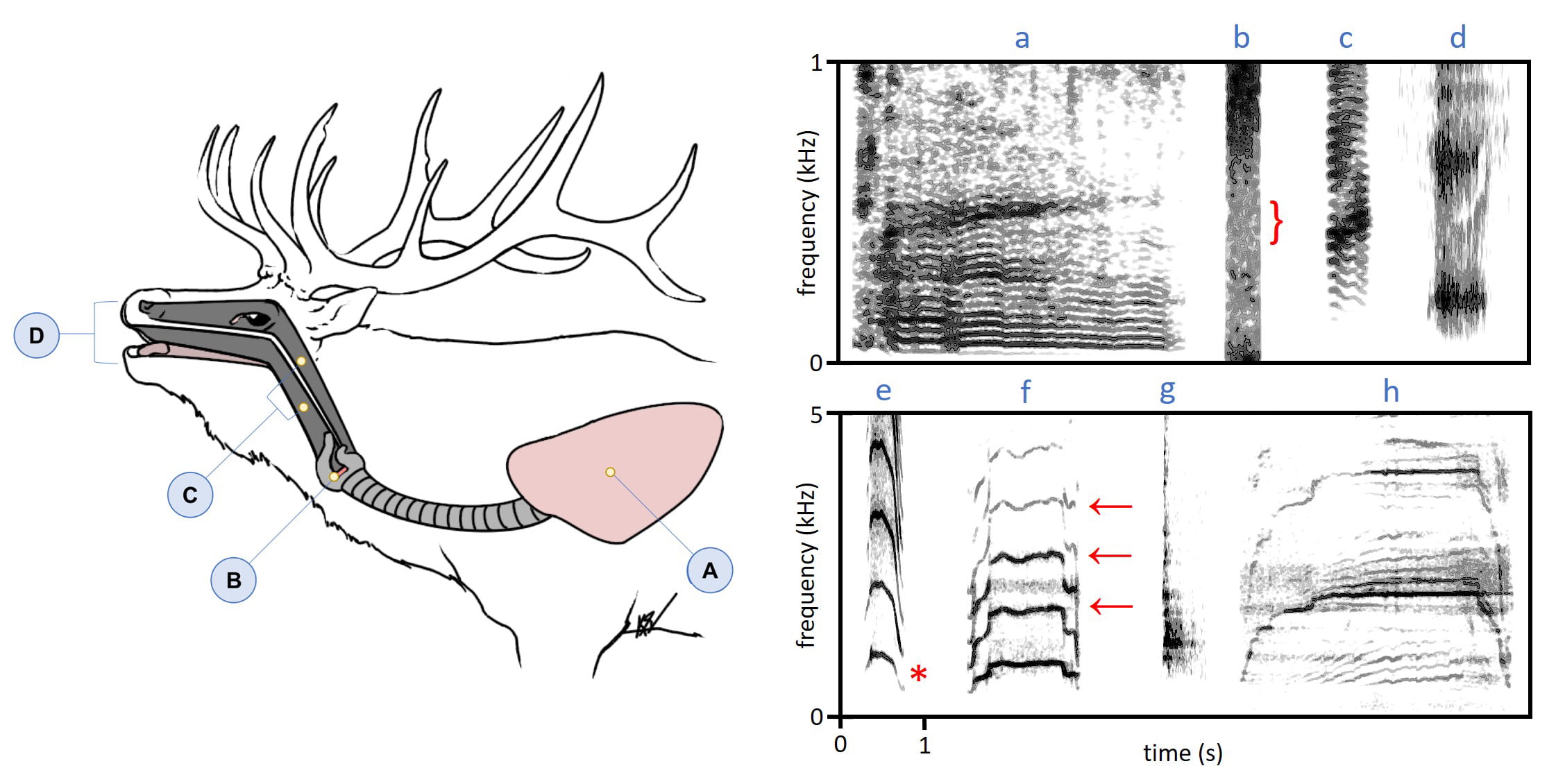
Figure 1. On left: Elk vocal anatomy including the (A) lungs, (B) vocal folds, (C) vocal tract & (D) nostrils, lips, and tongue. On right: spectrograms of a (a) bear growl, (b) mule deer alarm snort, (c) male mule deer grunt, (d) male plains bison short roar, (e) mule deer fawn cry, (f) coyote howl, (g) elk alarm bark and (h) male elk bugle. The asterisk (*) shows the pitch of the mule deer fawn cry, which typically corresponds to the lowest horizontal line on the graph or the frequency difference between successive harmonics; the arrows (←) point to the harmonics, which, if clear, make a sound tonal. The bracket (}) indicates a lack of harmonics in the atonal mule deer alarm snort. Elk vocal anatomy3Frey, R., & Riede, T. 2013. The anatomy of vocal divergence in North American elk and European red deer. Journal of Morphology, 274: 307-319 drawn by Kelsey Saboraki.
Grizzly Bear Growl (a)
Mule Deer Fawn cry (e)
Mule Deer Alarm Snort (b)
Coyote Howl (f)
Elk Alarm Bark (g)
Mule Deer Grunt (c)
Male Elk bugle (h)
Plains Bison Short Roar (d)
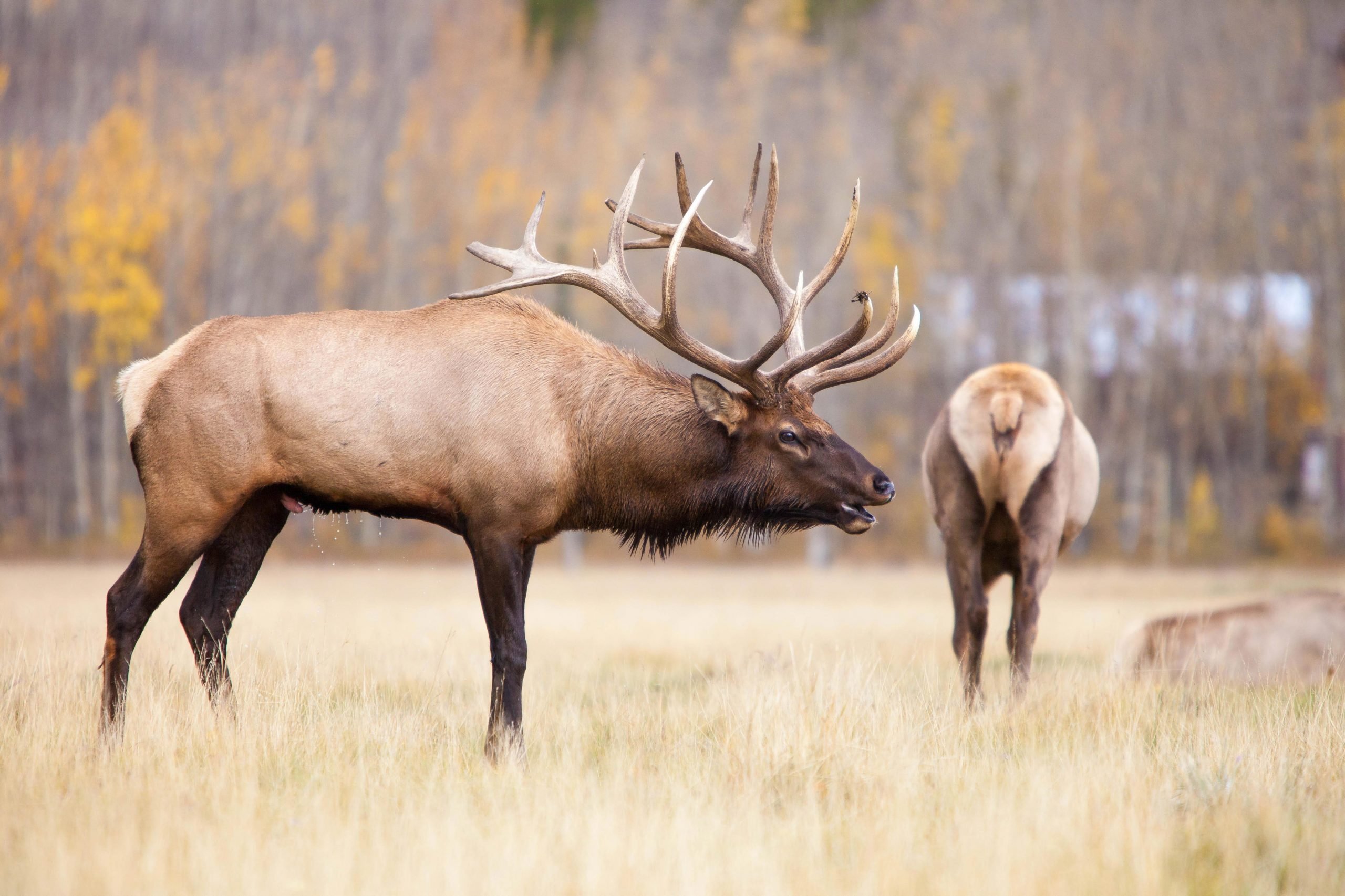
Elk stag bugles, Yukon Wildlife Preserve.
Acoustically, we can think of this as male courtship calls being low in pitch and having low resonance frequencies, since larger animals should have longer vocal folds and a longer, wider, vocal tract. This is referred to as ‘allometric scaling’ and is the reason baby animals tend to have higher voices compared to adults (see the mule deer fawn cry (e) compared to the mule deer courtship grunt (c) in Figure 1). There is evidence to support the Theory of Honest Advertisement in plains bison. Plains bison courtship calls with lower resonance frequencies are made by males with larger body sizes, and males who have lower resonance frequencies in their courtship calls have greater mating success.7Wyman, M.T., et al. 2012. Acoustic cues to size and quality in the vocalizations of male North American bison, Bison bison. Animal Behaviour: 84: 1381-1391

Mule deer fawn and doe, Yukon Wildlife Preserve
First and foremost, males need to ensure their courtship calls will actually reach the ears of potential mates. That is, we need to consider the venue in which males are making these sounds. If you take your date to a crowded restaurant, you want to be confident they are listening to you and only you when talking about your achievements. Just like ungulates that live in forests, you have to overcome direct physical barriers to your sound reaching your date. In the forest, trees and other vegetation more readily absorb or scatter high-pitched sounds than they do low-pitched sounds,9Marten, K., Quine, D., and Marler, P. 1977. Sound transmission and its significance for animal vocalization: II. Tropical Forest Habitats. Behavioral Ecology and Sociobiology, 2(3): 291-302. meaning high-pitched sounds may not travel very far or very clearly in this type of habitat. We might therefore expect forest-dwelling ungulates to use lower-pitched courtship calls. The low-pitched croaking of male moose is a good example of a forest-dwelling species whose courtship calls fit into this narrative.10Franzmann, A.W. 1981. Mammalian Species: Alces alces. The American Society of Mammalogists, 154: 1-7.

Moose Bull, Yukon Wildlife Preserve
Male ungulates also need to read the room. It would be overkill for your date to yell for your attention while you were having a nice quiet picnic, and the same is probably true for ungulate courtship. Mule deer males use low-amplitude, low-pitched grunting while engaged in a tending bond with a single female.11Geist, V. 1981. Behavior: adaptive strategies in mule deer. In: Mule deer and black-tailed deer of North America. Wallmo, O.C. (ed.). University of Nebraska, Lincoln. Pp 157-224. Contrast this with the literal screaming of a male elk attempting to entice an entire herd of females to stay in close proximity to him, and not to stray toward the lurking satellite males.12Murie, O.J. 1934. Elk Calls. Journal of Mammalogy, 13(4): 331-336 It seems reasonable that the social structure of ungulate species, in particular, their mating system type, would influence the acoustics of male courtship calls as well.
Finally, a discussion of male courtship sounds would not be complete without considering the target audience. We are not always sure if a male courtship call is meant specifically for a female, or whether it is a warning to potential rival males, or somehow a signal that targets both. In some cases, it is fairly clear the sound is meant for females – such as for wood bison males who purr only while engaged in a tending bond with a single female.13Olson, W.E. 2020. The silent bison: differences in rut vocalizations between breeding age male plains and wood bison. Timbergulch PressThe reaction of females or males to a courtship call may also suggest its function. For example, female elk tend to approach or at least alert to the high-pitched courtship calls of male elk.14Murie, O.J. 1934. Elk Calls. Journal of Mammalogy, 13(4): 331-336
It is widely accepted that tonal sounds (such as the mule deer cry (e) in Figure 1) are attractive to other animals, and atonal sounds (such as a mule deer snort (b) in Figure 1) are repelling to other animals.15Morton, E.S. 1977. On the occurrence and significance of motivation-structural rules in some birds and mammal sounds. The American Naturalist, 111(981): 855-869 If courtship calls of a given ungulate species are meant to entice females to approach or stay with a certain male, we might expect them to be tonal. Interestingly, the pitch of infant cries is known to be incredibly attractive to female ungulates,16Lingle, S., & Riede T. 2014. Deer mothers are sensitive to infant distress vocalizations of diverse mammalian species. The American Naturalist, 184(4). DOI: 10.1086/67767717Teichroeb, L.J., Riede, T., Kotrba, R., & Lingle, S. 2013. Fundamental frequency is key to response of female deer to juvenile distress calls. Behavioural Processes, 92: 15-23 so maybe the high pitch of male elk courtship calls grabs a female’s attention the same way an infant cry would.18Lingle, S., Wyman, M.T., Kotrba, R., Teichroeb, L.J., & Romanow, C.A. 2012. What makes a cry a cry? A review of infant distress vocalizations. Current Zoology, 58(5): 698-726.
L to R: Rebecca making a sound recording of moose at Yukon Wildlife Preserve; Cora making a sound recording of elk at Sandy Hills Elk Ranch.
The focus of my (Cora’s) Master’s thesis is to look at courtship calls from a diverse group of ungulate species that vary in their size, habitat, and mating system type, and to construct models to see which of these factors most readily correlates with the particular acoustic traits that make up the courtship calls. I will also compare the tonality and pitch of a species’ newborn cries with the tonality and pitch of male courtship calls. To do this properly, we require a large data set. Luckily, my good friend and colleague Rebecca Carter is set up with recording equipment that she will use to try and capture some of the courtship calls from ungulates at Yukon Wildlife Preserve. These recordings Rebecca collects will be combined with the elk courtship calls I recorded for my undergraduate thesis, and a library of courtship calls that my supervisor, Dr. Susan Lingle, has amassed through the years as well. I am also scouring the scientific literature for courtship calls of species we do not have access to.
Stay tuned for the results of this research, and remember that size probably isn’t the only thing that matters.
All sound clips credit Lingle Lab: Dr. Susan
Lingle’s Lab at the University of Winnipeg, with the exception of Grizzly Bear19https://www.nps.gov/yell/learn/photosmultimedia/grizzlysounds.htm and Mule Deer grunt 20https://yukon.ca/en/mule-deer
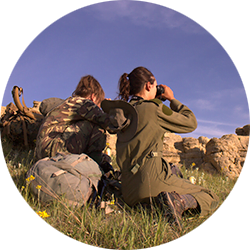
Cora Romanow & Rebecca Carter
Masters Student & YWP Wildlife Interpreter
Cora and Rebecca share a love for wildlife, nature, and sneaking up on and observing deer. They bonded over these shared loves back in Manitoba and on the Alberta grasslands while working in the same behavioural ecology lab, and remain passionate about animals; Cora completing her Masters in animal communication and Rebecca a wildlife interpreter here at the Preserve. Together they strive to make wildlife research accessible and relatable (and at times humorous) to inspire others to also love the natural world.
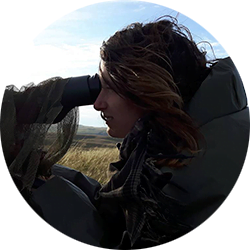
Kelsey Saboraki
Artistic Illustrations - Elk Anatomy Figure
Kelsey Saboraki is a keen observer of the natural world and her scientific illustrations reflect this. Her attention to detail is accompanied by an appreciation for the whole and this balance breathes life into even the most technical of diagrams. For inquiries, contact ksaboraki@gmail.com.

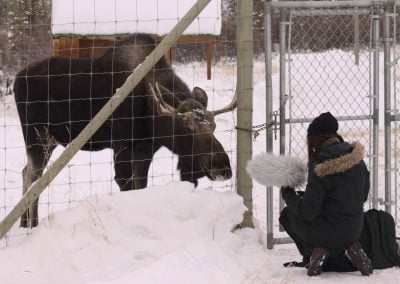
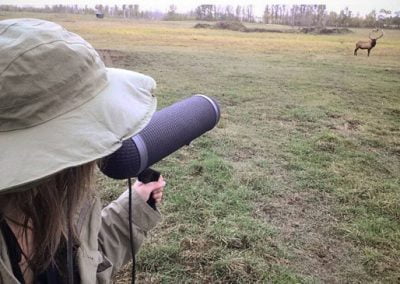
0 Comments